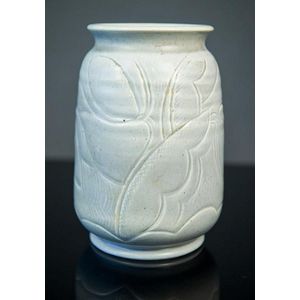Opalescent Laurier Vase by R. Lalique
You must be a subscriber, and be logged in to view price and dealer details.
Subscribe Now to view actual auction price for this item
When you subscribe, you have the option of setting the currency in which to display prices to $Au, $US, $NZ or Stg.
- Opalescent / Opaline - The descriptions of glass as "opalescent" or "opaline" are often used interchangeably by dealers and auction houses. At the upper end of the scale, opalescent / opaline glass can refer to the opal-like milky blue glass produced by Lalique and Etling. It also refers to the pressed glass mass produced in Britain from the 1840s with a milky white edge as sugar-basins, milk jugs and vases were made in great quantities for the mass market, and were sold at fairs along with Staffordshire figures and wooden dolls. A less common type of opalescent glass was made from two layers of glass blown into a mould.
- Etched - Glass decorated with an etched design, which is achieved through marking out the pattern, protecting the area that is not be etched, and then immersing the object in acid to dissolve the surface of the unprotected area. With some glass objects, such as cameo glass, there may be several layers of different coloured glass, and part of the top layer is dissolved leaving the bottom layer as the background. The longer the time of exposure of the object to acid, the deeper the etching.
The word etching is also sometimes used to describe another method of decoration, where wheel grinders were used decorate the surface, but this technique is usually known as engraving. - Circa - A Latin term meaning 'about', often used in the antique trade to give an approximate date for the piece, usually considered to be five years on either side of the circa year. Thus, circa 1900 means the piece was made about 1900, probably between 1895 and 1905. The expression is sometimes abbreviated to c.1900.
This item has been included into following indexes:
-
Lalique (France), item types
- other items 1,054
- vases 536
- Lalique (France), patterns, vases - Laurier 5
Visually similar items

A Cizhou black and green glazed pillow, Jin Dynasty (1115-1234), decorated with two birds amongst foliage, in green on a black ground. From Shanxi province, and probably from the Houma kiln. 14 cm high, 30 cm wide, 20.5 cm deep. Provenance: Capital Gallery

Aquamarine dress ring, an 8 mm x 8 mm cushion cut light blue stone set in a white gold four claw collet upon a 'Cartier' style patterned 18ct yellow gold flat band, size K, 3.9 grams

Klytie pate (1912-2010) A purple glazed earthenware vase carved with a band of stylised leaves, inscribed K. Pate 22 cm high

Susie Cooper vase. Grey glaze with incised floral decoration. Signed & dated 1932 to base. Height 18 cm
